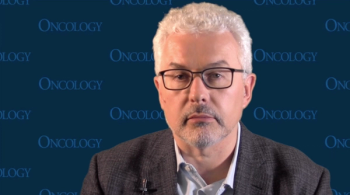
Momelotinib continues to show benefit in reducing splenic symptoms and anemia in myelofibrosis in the second-line setting, making it a likely first treatment choice, according to an expert from the University of Texas MD Anderson Cancer Center.

Your AI-Trained Oncology Knowledge Connection!


Momelotinib continues to show benefit in reducing splenic symptoms and anemia in myelofibrosis in the second-line setting, making it a likely first treatment choice, according to an expert from the University of Texas MD Anderson Cancer Center.

The panel closes their discussion on myelofibrosis treatment updates by sharing clinical pearls for community oncologists.

Experts delve into the unmet needs in the myelofibrosis treatment landscape and highlight promising ongoing clinical trials.

A look at sequencing strategies for myelofibrosis treatments.

Dr Srdan Verstovsek shares how he assesses myelofibrosis treatment response in his clinical practice.

Raajit Rampal, MD, explains how he considers safety profiles when deciding on appropriate treatment for myelofibrosis and how he manages toxicities for patients.

A discussion on when to switch a patient with myelofibrosis to a new JAK inhibitor treatment, and possible strategies for transitioning.

John Mascarenhas, MD, presents a clinical scenario of a 73-year-old man with myelofibrosis and a low platelet count.

A panel of experts considers treatment options for patients with myelofibrosis based on platelet counts, while factoring in health insurance barriers.

Raajit Rampal, MD, PhD, shares the treatment options he would consider for the presented clinical scenario.

A review of the approved treatments for myelofibrosis, including dosing guidelines and supporting clinical trial data.

Dr John Mascarenhas presents a patient case scenario of a 68-year-old woman with a common presentation of primary myelofibrosis.

Raajit Rampal, MD, describes the JAK-STAT pathway and how it’s fundamental to all types of myelofibrosis.

Aaron Gerds, MD, explains the various types of myelofibrosis and the underlying pathophysiologies.

Srdan Verstovsek, MD, PhD, provides an overview of how myelofibrosis is diagnosed and what criteria are used for risk stratification.

Responses to questions by community hematologists/oncologists regarding optimal ways to diagnose and manage patients with myelofibrosis.

Clinical pearls for planning and sequencing therapy for patients with myelofibrosis.

Second-line treatment considerations for a 75-year-old man with high-risk primary myelofibrosis who was previously treated with ruxolitinib.

Second-line therapies for myelofibrosis that are available or in the pipeline for use.

Circumstances for which hydroxyurea, ruxolitinib, or other therapy may be selected to treat newly diagnosed myelofibrosis.

Characteristics that contribute to treatment decisions for patients with newly diagnosed myelofibrosis

Criteria used to risk stratify and classify patients with newly diagnosed myelofibrosis and establish treatment paradigms.

The most common symptoms that present in patients with newly diagnosed myelofibrosis and variables that factor into initial treatment decisions.

The role of signaling pathways, mutations, and alterations in the development of myelofibrosis (MF), and characteristics that distinguish primary MF from secondary MF.

In this interview we discuss clinical developments in essential thrombocythemia, polycythemia vera, and myelofibrosis, as well as the latest treatment options.

Myeloproliferative neoplasms are a group of clonal myeloid cell–derived disorders characterized by myeloproliferation without dysplasia, bone marrow hypercellularity, and predisposition to thrombosis, hemorrhage, and bone marrow fibrosis.

By inhibiting inflammatory cytokines and controlling the signs and symptoms of myelofibrosis, the patient’s body condition improves as the disease is kept under good control. Ultimately, prolonged exposure of a patient with myelofibrosis to ruxolitinib at a clinically effective dose results in prolongation of the his or her life.

T-cell non-Hodgkin’s lymphomas are a heterogeneous group of diseases that differ markedly in terms of their clinical behavior and prognosis. In recently developed classification systems, the sites of initial disease

Published: July 15th 2022 | Updated:

Published: July 15th 2022 | Updated:

Published: June 27th 2022 | Updated:

Published: July 29th 2022 | Updated:

Published: July 15th 2013 | Updated:

Published: June 1st 2000 | Updated: